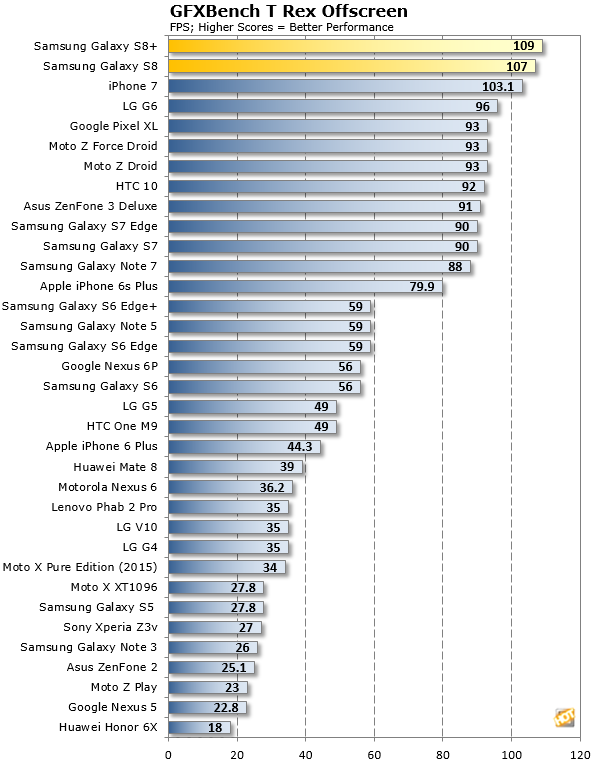Next we'll test the Galaxy S8 and
Galaxy S8+ with GFXBench, which has been one of our standard mobile graphics performance benchmarks for quite a while now. In order to ensure display refresh (v-sync) and resolution are not limiting factors, we are comparing Offscreen test results here. GFXBench tests OpenGL ES graphics workloads and we're specifically testing GLES 2.0 and 3.0 rendering performance in the following two benchmark modules.
 |
|
3D Graphics Benchmarks: 3DMark & GFX Bench |
|
Pushing The Pixels |
|


Here in GFXBench, we were able to pull in the iPhone 7 for testing, as well as virtually all the current Android flagships on the market. The Samsung
Galaxy S8 and Galaxy S8+ trade blows for the top position with the iPhone 7 and show stronger performance in GLES 2.0 workloads in the T-Rex test. Perhaps there's a bit more tuning to do here still for the Snapdragon 835 in OpenGL ES 3.0 and higher API-based engines.
We also ran with Futuremark's 3DMark benchmark, which has been a staple 3D graphics benchmark at HotHardware across all mobile and desktop platforms for many years. In this case we were running
3DMark Ice Storm Unlimited, which is targeted for mobile devices and also runs at 720p in offscreen mode, so as to take display resolution out of the equation. This test and its 3D graphics engine is also based on the Open GL ES 2.0 API.


In the overall test, the new Samsung Galaxy S8 and Galaxy S8+ flank the iPhone 7 with competitive graphics horsepower and strong physics throughput. The results are generally the same as well, the more we dig into the details in the GT1 and GT2 test modules that are measured in Frame Per Second. Either way, as you can see, the Galaxy S8 and Galaxy S8+ crush other current gen Android handsets here, though finally we have an Android phone that's roughly on parity with the iPhone 7's graphics performance; sometimes surpassing it, other times trailing.
 Futuremark 3DMark Sling Shot Extreme Benchmark
Futuremark 3DMark Sling Shot Extreme Benchmark3DMark Sling Shot is a new benchmark module that's been added to the 3DMark mobile suite, so again we have fewer results in our database to share, though we do have a few top-shelf Android phones, the iPhone 7 and Samsung's previous-gen Galaxy S7 in the mix. Sling Shot is a much more advanced OpenGL ES 3.1 and Metal API-based test that employs some advanced rendering techniques like volumetric lighting and particle illumination. In this test we again run the Offscreen mode, so as to remove display resolution differences from the equation and thus can compare cross-platform results more reliably.

In Sling Shot Extreme the tables turn dramatically in favor of the new Samsung Galaxy S8 and Galaxy S8+ that are powered by the new
Qualcomm Snapdragon 835. If we do the math, the Galaxy S8 and Galaxy S8+ are about 25 percent faster than the previous generation Snapdragon 820/821 based Android smartphones here, as well as the Apple A10-powered iPhone 7. We can also see physics processing is again about that much faster (25%), at least according to 3DMark Sling Shot.
So there's serious firepower under the hoods of the Samsung Galaxy S8 and Galaxy S8+ but let's check in on battery life and then we'll wrap things up...












